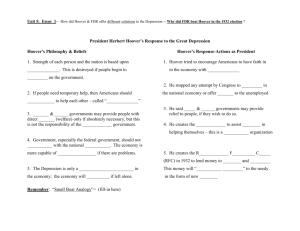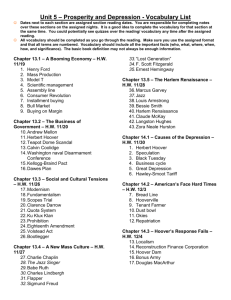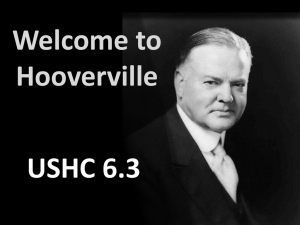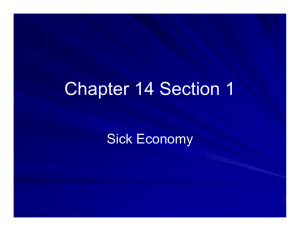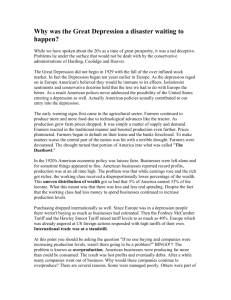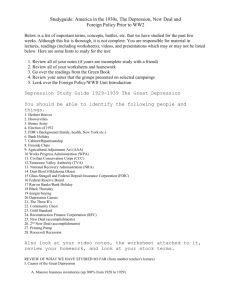Ch 14 The Great Depression Sec 1 The Nation's
advertisement
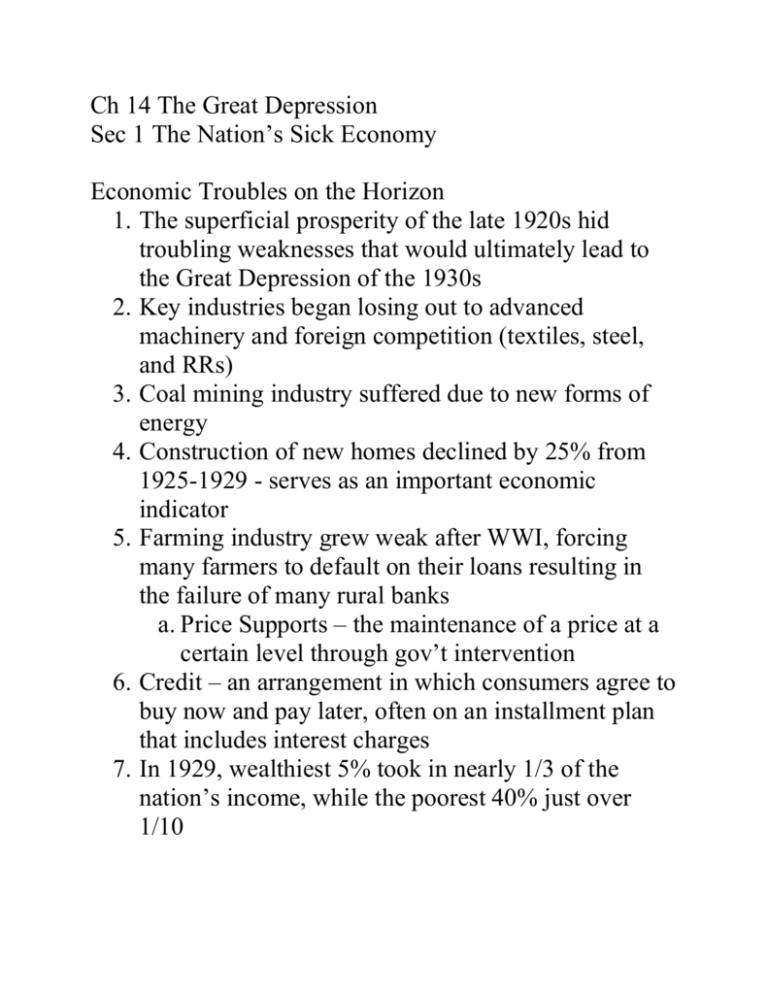
Ch 14 The Great Depression Sec 1 The Nation’s Sick Economy Economic Troubles on the Horizon 1. The superficial prosperity of the late 1920s hid troubling weaknesses that would ultimately lead to the Great Depression of the 1930s 2. Key industries began losing out to advanced machinery and foreign competition (textiles, steel, and RRs) 3. Coal mining industry suffered due to new forms of energy 4. Construction of new homes declined by 25% from 1925-1929 - serves as an important economic indicator 5. Farming industry grew weak after WWI, forcing many farmers to default on their loans resulting in the failure of many rural banks a. Price Supports – the maintenance of a price at a certain level through gov’t intervention 6. Credit – an arrangement in which consumers agree to buy now and pay later, often on an installment plan that includes interest charges 7. In 1929, wealthiest 5% took in nearly 1/3 of the nation’s income, while the poorest 40% just over 1/10 a. Unequal distribution of wealth meant that the prosperity of the 1920s rested on a fragile foundation Election of 1928 1. Herbert Hoover (Rep) vs. Alfred E. Smith (Dem) 2. Hoover’s Advantage – could point to years of prosperity under Republican administrations since 1920 3. Hoover won with 444 electoral votes and 58% of the popular vote Dreams of Riches in the Stock Market 1. Speculation – buying stocks and bonds on the chance that they might make a quick profit, ignoring the risks a. Wealth was generated on paper but bore little relation to the real worth of companies 2. Buying on Margin – paying a small percentage of a stock’s price as a down payment and borrowing the rest a. If stocks declined, there was no way to pay off the loan 3. Black Tuesday – Oct 29, 1929, the bottom fell out of the market a. 16 million shares of stock were dumped in one day b. Investors lost $30 million dollars Great Depression – 1929-1941, period in which the economy was in severe decline and millions of people were out of work -Causes: 1. Old and decaying industrial base 2. Crisis in the farm sector 3. Availability of easy credit 4. Unequal Distribution of Wealth – too little money in the hands of the working people, who were the vast majority of consumers Dow Jones Industrial Average – most widely used barometer of the stock market’s health, measure based on the prices of 30 large firms trading on the New York Stock Exchange 1. Prior to crash, had reached a high of 381 points 2. Fell dramatically on Oct 28th and 29th and continued to fall until 1932 Financial Collapse 1. Bank Closures – Americans panicked and withdrew their money from banks, many banks couldn’t cover withdrawals because they had invested and lost money in the stock market a. 1929 – 659 closed b. 1933 – 6,000 had failed, ¼ of the nation’s banks c. Wiped out 9 million individual savings accounts 2. Business Failures – 85,000 businesses went bankrupt including many automobile and RR industries 3. Unemployment – leaped from 3% in 1929 to 25% by 1933 (13 million workers) Worldwide Shock Waves 1. European nations were still recovering from WWI and faced large amounts of debt 2. America could no longer import large amounts of European goods, thus American farm and industrial products were not purchased in large numbers abroad 3. Hawley-Smoot Tariff – 1930, established the highest protective tariff in U.S. history a. By reducing the flow of goods into the U.S., it prevented other countries from earning money to buy American products b. Made unemployment worse and many European nations retaliated with large tariffs themselves Section 2 Hardship and Suffering During the Depression Depression in the Cities 1. Shantytowns – little towns largely consisting of shacks 2. Soup Kitchens – places where found is offered free to the needy 3. Bread Lines – lines of people waiting to receive food provided by charitable organizations or public agencies 4. African Americans and Latinos – both faced higher unemployment rates than whites and many were the targets of violence Depression in Rural Areas 1. Many farms were lost through foreclosure 2. Many farmers had no choice but to turn to tenant farming in order to barely scrape out a living Dust Bowl – region from Texas to North Dakota 1. Drought hit the Great Plains in the 1930s 2. Farmers had exhausted the land through overproduction and the grasslands became unsuitable for farming 3. With little grass and few trees to hold the soil down, major dust storms resulted because of the wind and drought (Kansas, Okalahoma, and Texas were hardest hit) 4. Okies – negative term used for all migrants who left their farms behind and traveled Route 66 to California Effects on the American Family 1. Men had difficulty coping with unemployment because they had been accustomed to working and supporting their families 2. Direct Relief – giving of money or food by the gov’t to needy people (didn’t exist during the early years of the depression) 3. Women canned food and sewed clothes while trying to manage household budgets a. Those who held jobs, especially married women, faced tremendous resentment 4. Children suffered from malnutrition and diet-related diseases a. School years were shortened and some schools were even closed Section 3 Hoover Struggles with the Depression Hoover’s Philosophy of Government – gov’t could play a role in helping to solve economic problems, but the key was to limit that role and prevent gov’t from taking too much power 1. Not a career politician, found it difficult to compromise 2. One of government’s chief functions was to foster cooperation between competing groups and interests in society 3. “Rugged Individualism” – people should succeed through their own efforts a. Opposed any form of federal welfare or direct relief, that was the responsibility of individuals, charities, and local organizations Congressional Elections of 1930 1. Democrats took advantage of anti-Hoover sentiment a. Hoovervilles, Hoover blankets, and Hoover flags 2. Republicans lost control of the House and only had a one vote majority in the Senate Hoover Takes Action 1. Boulder Dam (Hoover Dam) – built on the Colorado River on the border of Arizona and Nevada, part of a public works program intended to stimulate business and provide jobs 2. Federal Home Loan Bank Act – lowered mortgage rates fro homeowners and allowed farmers to refinance their farm loans in order to avoid foreclosure 3. Reconstruction Finance Corporation (RFC) – 1932, authorized to provide emergency financing to banks, life insurance companies, RRs, and other large businesses a. Intended to pump new life into the economy by fueling business expansion (too little, too late) Bonus Army – group of unemployed WWI veterans and their families who marched on D.C. in 1932 to demand payment of a bonus they had been promised for military service 1. Patman Bill – authorized a bonus to be paid out to WWI veterans in 1945 in the form of a life insurance policy a. Patman wanted the money to be paid out immediately, Bill was voted down my the Senate 2. Hoover asked for the Bonus Army to leave after the Bill was not passed, but some refused 3. Hoover, fearing violence, sent part of the U.S. military to disband them 4. The military gassed more than 1,000 people, killing a young child and injuring many

